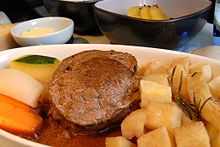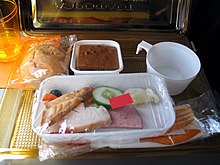This is an old revision of this page, as edited by GamerPro64 (talk | contribs) at 05:39, 25 October 2014 (Adding some information into caption). The present address (URL) is a permanent link to this revision, which may differ significantly from the current revision.
Revision as of 05:39, 25 October 2014 by GamerPro64 (talk | contribs) (Adding some information into caption)(diff) ← Previous revision | Latest revision (diff) | Newer revision → (diff)


An airline meal or in-flight meal is a meal served to passengers on board a commercial airliner. These meals are prepared by airline catering services.
These meals vary widely in quality and quantity across different airline companies and classes of travel. They range from a simple beverage in short-haul economy class to a seven-course gourmet meal in long-haul first class. When ticket prices were regulated in the American domestic market, food was the primary means airlines differentiated themselves.
History
The first airline meals were served by Handley Page Transport, an airline company founded in 1919, to serve the London-Paris route in October of that year. Passengers could choose from a selection of sandwiches and fruit.
Contents

The type of food varies depending upon the airline company and class of travel. Meals may be served on one tray or in multiple courses with no tray and with a tablecloth, metal cutlery, and glassware (generally in first and business classes).
The airline dinner typically includes meat (most commonly chicken or beef) or fish, a salad or vegetable, a small bread roll, and a dessert.
Caterers usually produce alternative meals for passengers with restrictive diets. These must usually be ordered in advance, sometimes when buying the ticket. Some of the more common examples include:
- Cultural diets, such as French, Italian, Chinese, Japanese or Indian style.
- Infant and baby meals. Some airlines also offer children's meals, containing foods that children will enjoy such as baked beans, mini-hamburgers and hot dogs.
- Medical diets, including low/high fiber, low fat/cholesterol, diabetic, peanut free, non-lactose, low salt/sodium, low-purine, low-calorie, low-protein, bland (non-spicy) and gluten-free meals.
- Religious diets, including kosher, halal, and Hindu, Buddhist and Jain vegetarian (sometimes termed Asian vegetarian) meals.
- Vegetarian and vegan meals. Some airlines do not offer a specific meal for vegetarians; instead, they are given a vegan meal.
For several Islamic airlines (e.g. Emirates, Etihad Airways, Gulf Air, Iran Air, Qatar Airways, Saudia, Pakistan International Airlines, and Malaysia Airlines) in accordance of Islamic customs, all classes and dishes on the plane are served a Muslim meal with Halal certification - without pork and alcohol. While Emirates, Etihad, and Qatar are still providing bottles of wine to non-Muslim passengers, the cabin crew does not deliver alcoholic beverages lest to violate Islamic customs, unless those non-Muslim passengers request it. Because Iran and Saudi Arabia are apply strict Sharia regulations, all Iran Air and Saudia airplanes do not deliver pork and alcoholic substances; moreover, all airlines flying to and from Iran or Saudi Arabia are prohibited from using pork and alcohol.
In the case of El Al, all meals are Kosher-certified by Rabbis. Even destinations outside Israel, sky chefs must be supervised by rabbis to make kosher meals and load their planes.
Cutlery and tablewares
Before the September 11 attacks in 2001, first class passengers were often provided with full sets of metal cutlery. Afterward, common household items were evaluated more closely for their potential use as weapons on aircraft, and both first class and coach class passengers were restricted to plastic utensils. Some airlines switched from metal to all-plastic or plastic-handled cutlery during the SARS outbreak in 2003, since the SARS virus transfers from person to person easily, and plastic cutlery can be thrown away after use. Many airlines later switched back to metal cutlery.
In May 2010, concerns were raised in Australia and New Zealand over their respective flag carriers, Qantas and Air New Zealand, reusing their plastic cutlery for international flights between 10 and 30 times before replacement. Both airlines cited cost saving, international quarantine, and environmental as the reasons for the choice. Both have also said that the plastic cutlery is commercially washed and sterilized before reuse. Reusing plastic tablewares though is a regular thing among many airliners and food caterers.
Other non-food items
Condiments (typically salt, pepper, and sugar) are supplied in small sachets. For cleanliness most meals come with a napkin and a moist towelette. First and business class passengers are often provided with hot towels and actual salt and pepper shakers.
Breakfast

During morning flights a cooked breakfast or smaller continental-style may be served. On long haul flights (and short/medium haul flights within Asia) breakfast normally includes an entrée of pancakes or eggs, traditional fried breakfast foods such as sausages and grilled tomatoes, and often muffins or pastries, fruits and breakfast cereal on the side. On shorter flights a continental-style breakfast, generally including a miniature box of breakfast cereal, fruits and either a muffin, pastry, or bagel. Coffee and tea are offered as well, and sometimes hot chocolate.
Cost
Food on board a flight is usually free on full-service European and Asian airlines and on almost all long-distance flights, while they might cost extra on low-cost airlines or flights. Quality may also fluctuate due to shifts in the economics of the airline industry, with private jet passengers receiving the equivalent of five-star food service.
On long-haul international flights in first class and business class, most Asian and European airlines serve gourmet meals, while legacy carriers based in the US tend to serve multicourse meals including a cocktail snack, appetizer, soup, salad, entrée (chicken, beef, fish, or pasta), cheeses with fruit, and ice cream. Some long-haul flights in first and business class offer such delicacies as caviar, champagne, and sorbet (intermezzo).
The cost and availability of meals on US airlines has changed considerably in recent years, as financial pressures have inspired some airlines to either begin charging for meals or abandon them altogether in favor of small snacks (Southwest Airlines). Eliminating free pretzels saved Northwest $2 million annually. The carrier lost nearly $3.3 billion since 2001. Nowadays, US legacy carriers (American, Delta and United) have discontinued full meal service in tourist class on intra-US runs while retaining it for most intercontinental routes (full meal service has in large part been retained by these carriers in premium classes though), offering instead snacks for purchase; and at least one European carrier (Icelandair) follows this policy on intercontinental runs as well.
Air China has reported that each domestic flight's meal requires RMB50 (US$7.30) while international flights require RMB70 (US$10). However, this figure varies from airline to airline, as some have reported costs to be as low as US$3.50. Air China is also minimizing costs by loading only 95% of all meals to reduce leftovers and storing non-perishable foods for emergencies.
In 1958 Pan Am and several European airlines entered into a legal dispute over whether certain airline food sandwiches counted as a "meal".
Preparation

Meals must generally be frozen and heated on the ground before takeoff, rather than prepared fresh. Guillaume de Syon, a history professor at Albright College who wrote about the history of airline meals, said that the higher altitudes alter the taste of the food and the function of the taste buds; according to de Syon the food may taste "dry and flavorless" as a result of the pressurization and passengers, feeling thirsty due to pressurization, many drink alcohol when they ought to drink water. Tests have shown that the perception of saltiness and sweetness drops 30% at high altitudes. The low humidity in airline cabins also dries out the nose which decreases olfactory sensors which are essential for tasting flavor in dishes.
Food safety is paramount in the airline catering industry. A case of mass food poisoning amongst the passengers on an airliner could have disastrous consequences. For example, on February 20, 1992, shrimp tainted with cholera was served on Aerolíneas Argentinas Flight 386. An elderly passenger died and other passengers fell ill. For this reason catering firms and airlines have worked together to provide a set of industry guidelines specific to the needs of airline catering. The World Food Safety Guidelines for Airline Catering is offered free of charge by the International Flight Service Association.
See also
- Bento
- Cara Operations
- Chelsea Food Services
- Dnata
- Gate Gourmet
- Kosher airline meal
- LSG Sky Chefs
- Servair
- Singapore Airport Terminal Services (SATS)
- TV dinner
- Flying Food Group
References
- Ronalds-Hannon, Elizabeth. "Free peanuts on airplanes started out as a marketing ploy". Quartz. The Atlantic Media Company. Archived from the original on November 3, 2013. Retrieved August 6, 2013.
- "British Civil Aviation in 1919 - Part 1". Interactive aviation timeline. London NW9 5LL, United Kingdom: Royal Air Force Museum. Archived from the original on October 11, 2013. Retrieved October 11, 2013.
11 October: The first airline meals are served by Handley Page Transport, when passengers are offered a pre-packed lunch-box, costing 3 shillings, on their London to Paris service.
{{cite web}}: Unknown parameter|deadurl=ignored (|url-status=suggested) (help)CS1 maint: location (link) - Haigh, Gideon (2004). The Tencyclopedia. Text Publishing. ISBN 978-1-920885-35-9. Retrieved February 7, 2013.
- Vass, Beck (May 19, 2010). "Airlines use plastic cutlery up to 10 times". The New Zealand Herald. Archived from the original on January 7, 2014. Retrieved May 8, 2011.
- "Airlines reusing plastic cutlery". Television New Zealand. May 19, 2010. Archived from the original on July 1, 2013. Retrieved May 8, 2011.
- Marcus, Caroline (May 17, 2010). "Airline 'reuses plastic cutlery 30 times'". The Sunday Telelgraph. Archived from the original on May 20, 2010. Retrieved May 8, 2011.
- "American Airlines Inflight Dining, Recipes, Menus And More On". Aa.com. October 25, 2012. Archived from the original on January 22, 2014. Retrieved December 11, 2013.
- "Airline Meals & Delta Dining | Delta Air Lines". Delta.com. November 10, 2013. Archived from the original on April 26, 2013. Retrieved December 11, 2013.
- "United Airlines - Inflight dining". United.com. September 22, 2013. Archived from the original on April 20, 2014. Retrieved December 11, 2013.
- "Icelandair information: flights to Iceland, destinations, schedules & more - Icelandair". Icelandair.us. Archived from the original on February 13, 2014. Retrieved December 11, 2013.
- Li, Jiaxiang (2008). My Way The Eight Strategies of Air China Towards Success. China: Cengage Learning. p. 241. ISBN 978-981-4239-58-5.
- "The Death of the Airline Meal" MSN Money. Accessed May 2011. Archived 2013-03-12 at the Wayback Machine
- "Airline Says Rivals Violate Rule By Epic, Epicurean Sandwiches; Smorgasbord on Bread Hardly a Tidbit, Pan American Protests, Citing Pact Against Meals on Cut-Rate Flights." The New York Times. Saturday April 12, 1958. Business Financial, Page 38. Retrieved on January 12, 2010.
- de Syon, Guillaume (2009). "Is it Really Better to Travel than to Arrive? Airline Food as a Reflection of Consumer Anxiety". In Rubin, Lawrence C. (ed.). Food for Thought: Essays on Eating and Culture. McFarland. pp. 199–209.
- "Airlines enlist gourmet chefs to draw first-class fliers". Associated Press/CNN. April 29, 2008. Archived from the original on September 15, 2008.
- "The Real Reason Airline Food Tastes so Bad". travelmail reporter. April 14, 2014. Archived from the original on May 28, 2014.
- World Food Safety Guidelines for Airline Catering (PDF), International Flight Service Association, 2010, archived from the original (PDF) on December 28, 2013, retrieved December 27, 2013
| Independent and Airline Firm owned Catering companies | |
|---|---|
| Current | |